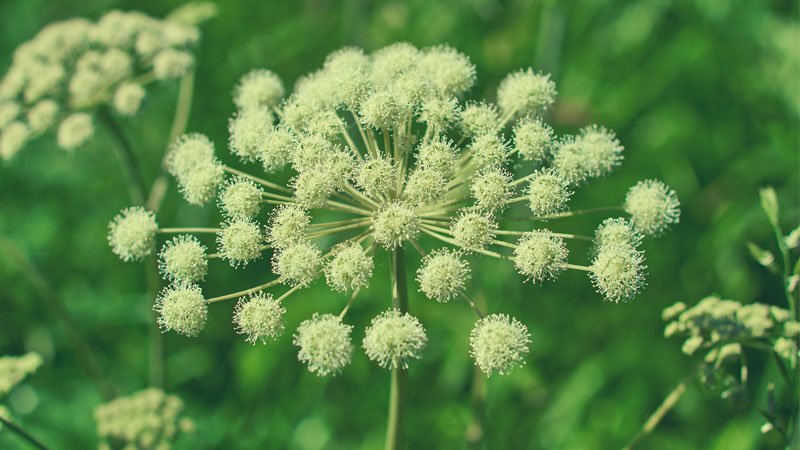Angelica (Angelica archangelica), also known as Wild Celery is a strongly aromatic perennial plant belonging to the Apiaceae family. Native to Northern-Europe, but now cultivated throughout the continent, it can grow to over 6 feet in height, producing ferny/feather-shaped, hairy leaves and umbels of greeny-white, honey-scented flowers. It likes to grow in damp soil, especially near rivers or deposits of water.
Angelica Root essential oil, as the name indicates, is steam-distilled from the plant’s roots and large rhizome. In order to ensure the finest quality and maximum yield the roots are carefully lifted manually in Autumn when the weather is dry and when the plant becomes dormant. It takes approximately 1kg of plant material to produce between 4 and 8ml of Angelica essential oil, which is why it is relatively expensive to buy.
Angelica oil can also be extracted from the plant’s seeds, but the root oil is considered to be superior in terms of fragrance and therapeutic effects.
Angelica Root oil has an unusual, rich, cleansing aroma, that is herbaceous and earthy with a hint of spice and aniseed. It is clear to pale yellow in colour when first distilled but can darken over time to a yellowy-brown.
Traditional uses:
Angelica has been used as a medicinal plant since antiquity. According to folklore the herb was named after the archangel Michael, who revealed its medicinal uses to a monk, and because it was said to have flowered on Saint Michael’s Day (8th May).
It was also known as Holy Spirit Root, Angel Grass and Herb of the Angels due to its extensive healing powers. It was traditionally used as a general tonic, to restore strength and stamina during convalescence, for bronchial ailments, coughs, colds, digestive problems and for stimulating the appetite. Many writers including Swiss physician and chemist, Paracelsus, and botanist Gerard, claimed that it gave protection against the plague, and it was also thought to ward off evil spirits and guard against witchcraft.
The Chinese have traditionally used at least ten different varieties of Angelica for medicinal purposes. Known as the ‘Empress of herbs’ it is one of their most widely used herbs second only to Ginseng. It is used for respiratory, circulatory, fertility and menstrual problems and a variety known as Dong Kwai is increasingly being used as an alternative to artificial hormones during menopause.
The plant is used extensively for flavouring foods and drink, including certain gins, vermouth and liqueurs such as Benedictine and Chartreuse. The ribbed, hollow stems can be added to stewed fruit or candied and used in baking, and the essential oil is commonly used in perfumes, toiletries and cosmetics.
In aromatherapy the oil is known for its antispasmodic, carminative, depurative, digestive, diuretic, emmenagogue, expectorant, febrifuge, nervine, stimulant, stomachic, sudorific and tonic properties. It is also reported to be antibacterial and antifungal (Lawless, 1995).
Main therapeutic uses of Angelica Root essential oil:
Although Angelica isn’t widely used in aromatherapy, it has many valuable properties that can often help when other oils fail.
- Tonic – Angelica is a good choice for strengthening the immune system and restoring strength and stamina during convalescence, when a person is anaemic or generally feeling weak. Patricia Davis, In her Aromatherapy A-Z book, also states that it may be beneficial for people suffering with M.E. (Chronic Fatigue).
- Respiratory tonic / expectorant – useful for a wide variety of respiratory infections including the common cold, bronchitis and chronic coughs – particularly dry, irritating coughs. It is also indicated for asthma.
- Circulatory stimulant – helps to boost the circulation and warm cold extremities.
- Anti-spasmodic – can help to ease joint, muscular and digestive pain (i.e. trapped wind/bloating).
- Digestive – can help combat nausea, indigestion, flatulence, constipation and loss of appetite. It can be especially useful where digestive problems are stress-related and is also thought to be helpful for anorexia.
- Nerve tonic – helps to relieve stress, tension and fatigue and can help you to keep going when feeling “faint-hearted’. In her book “Fragrant Mind” Valerie Ann Worwood also describes Angelica essential oil as being useful for balancing mood swings. It blends well with Geranium, Cypress, Cedarwood and Lavender – all of which can be useful to help ease emotional “highs and lows”.
- Detoxifier / Diuretic – helps clear the mind and stimulates the body’s ability to clear and cleanse itself by supporting the elimination organs – liver, kidneys and skin. It is often used in detox blends and lymphatic drainage massage and is valuable for treating arthritis, rheumatism, fluid retention and cellulite.
- Skincare – Angelica has a calming, soothing, healing effect on the skin that is beneficial for skin problems such as eczema, psoriasis and breakouts. It can also help to tone, rejuvenate and revitalise a dull, dry, lacklustre complexion and restore the skin’s microbial balance.
Aromatherapy blends using Angelica essential oil:
- For catarrhal congestion following a cough or cold try a steam inhalation with 1 drop each of Angelica, Thyme and Ginger, and 2 drops Lemon.
- For cold extremities related to fatigue, try regular massage with 30ml Sweet Almond Oil, 1 drop Ginger, 2 Black Pepper, 2 Angelica Root Oil and 10 drops Lavender.
- For IBS pain (trapped wind) massage abdomen clockwise with 20ml warmed Grapeseed Oil, 4 drops Mandarin essential oil, 2 Fennel, 2 Angelica Root and 1 Peppermint.
- For digestive problems try clockwise abdominal massage or foot massage with 30ml Sweet Almond Oil, 2 drops Angelica Root essential oil, 2 Spearmint, 2 Ginger and 6 Sweet Orange.
- To help ease joint pain/gout, bathe with 15ml Bath & Shower Gel blended with 8 drops Lavender essential oil, 4 Juniperberry, 2 Angelica and 2 German Chamomile.
- For emotional fatigue/high pressure, vaporise 4 drops Geranium and 2 drops Angelica.
- For congestion/cellulite try regular massage using long strong strokes in an upwards direction towards the heart – using 30ml Grapeseed Oil, 4 drops Juniperberry, Cypress and Geranium, and 2 Angelica.
- To soothe pre-menstrual tension (PMS) diffuse 6 drops Angelica, 5 drops Clary Sage and 3 drops Geranium for short bursts in the days leading up to your period.
Safety
Angelica Root essential oil can be a mild sensitizer so avoid in baths or massage if you have sensitive skin. It is also phototoxic so do not use on the skin before direct contact with sunlight. Avoid if pregnant or diabetic.
Sharon Lovett
Marketing Manager
References:
DAVIS. P. Aromatherapy – An A-Z. Revised and enlarged ed. C. W. Daniel. 1995.
LAWLESS. J. The Illustrated Encyclopedia of Essential Oils. Element Books. 1995.
PEACE RHIND. J. Essential Oils – A Handbook for Aromatherapy Practice. 2nd ed. Singing Dragon. 2012.
WORWOOD. V. A. The Fragrant Mind. Doubleday. 1995.

